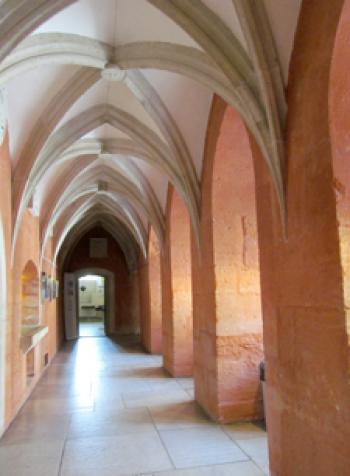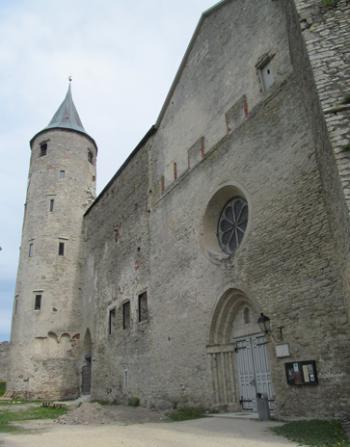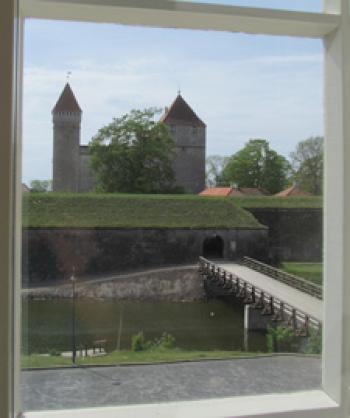Estonia - A bishop’s castle in Old Livonia
This item appears on page 47 of the February 2020 issue.
Tallinn, Estonia’s capital, is one of the gems of the Baltic states, a cluster of three small countries that also includes Latvia and Lithuania. They are all located along the eastern shores of the Baltic Sea in Northeastern Europe.
It would be easy to spend all of your time in Tallinn without venturing beyond. Its Old Town alone, with Hanseatic-era guildhalls and merchants’ houses, kept my husband, Paul, and me happily occupied for three days of our 8-day visit in May 2019. Wonderful as the Old Town is, the 2-day excursion we made outside Tallinn to the island of Saaremaa was the highlight of our stay in Estonia.
Saaremaa, located 130 miles southwest of Tallinn, is Estonia’s largest island. In mid-May at the beginning of the tourist season, it was still peaceful and uncrowded, a place to leisurely enjoy deserted beaches, old stone churches, nature walks and windmills.
The prize for us on Saaremaa, however, was Kuressaare Castle in the town of Kuressaare, which is itself a must-see destination, with old wooden houses and 18th/19th-century manor houses.
History of the castle
Kuressaare Castle’s history goes back almost 700 years. It was part of Old Livonia, which consisted then of several bishoprics plus large portions of what is today Estonia and Latvia under the control of the Livonian Order. This order was composed of warrior-monks who considered it their mission to Christianize this part of then-pagan Europe.
One of the bishoprics of Old Livonia was Ösel-Wiek (in Estonian, Saare-Lääne), which owned lands in western Estonia. The bishop’s main early-13th-century residence was in Haapsalu, on the mainland. Around 1338, the Haapsalu bishop began building Kuressaare Castle.
This castle was subsequently to suffer a much-checkered history, as it was handed over to the Danes in 1559, then to the Swedes barely a hundred years later in 1645. During the Great Northern War (1700-1721), which pitted Russia against Sweden, Kuressaare Castle was extensively damaged, not to be repaired for decades afterwards.
Fortunately, much remained and has been preserved, reconstructed or rebuilt into the magnificent structure you can visit today.
Castle exterior
Before entering the castle itself, you should pause to examine the wonderfully preserved area surrounding the castle: the artificial island on which the castle stands, the wide moat, remnants of outer walls, ravelins (triangular fortifications) pointing out into the moat and defense towers capped with orange turrets.
The castle, a solid quadrangular building with a fierce-looking portcullis ready to be slammed down on would-be invaders, was meant to be a fortress as well as a residence. Nevertheless, it fell to the enemy a number of times over the centuries.
Inside the castle
Inside the castle, beyond the portcullis, lies a small courtyard. From there, you can follow a self-guided tour to enter a utilitarian basement, where the castle’s furnace, brewery and storage rooms were located. Stairs lead up to the ground floor.
The ground floor is the main floor of the castle. It served a dual function as the home of the bishop when he visited and as a monastery for the resident monks. The rooms on this floor are linked by the elegant vaulted cloister arcade.
After a look at the dormitory, which was once the communal sleeping quarters of the monks, you enter a spacious arched hall with two aisles that served as both refectory for dining and chapter house for meetings. In a corner is the masterpiece altar relief, “The Coronation of St. Mary,” carved by Lübeck (Germany) artist Henning von der Heide about 1497-1500. The smaller square room next door is the chapel.
At the opposite end from the chapel were the bishop’s private apartments, a series of rooms supported by octagonal pillars. On some of the walls are displayed large, elaborate woodcarvings, the coats-of-arms of past Saaremaa noblemen. The upper floor of the castle that once housed soldiers now has exhibits devoted to Saaremaa’s long, eventful history.
Kuressaare Castle (Saaremaa, Estonia; phone +372 455 4463, www.saaremaamuuseum.ee) is open from 10 to 7 daily from May through August and from 11 to 6, Wednesday to Sunday, from September through April. Admission is €8, about $9.
Haapsalu Castle
On the drive back to Tallinn, Paul and I detoured to visit Haapsalu Castle in the small town of Haapsalu, 100 miles from Kuressaare Castle and 60 miles from Tallinn.
Haapsalu Castle (phone +372 518 4664, www.salm.ee) was the bishop of Ösel-Wiek’s principal residence. The bishopric was dissolved after the Livonian War, which involved quite an array of countries, including Denmark, Sweden, Norway, Russia and the Kingdom of Poland & the Grand Duchy of Lithuania, over a period of 25 years (1558-1583). The castle was partially destroyed during the war and suffered even more destruction in the Great Northern War.
At the time of my visit, the castle was undergoing extensive reconstruction, but visitors could still wander around its grounds (7 a.m.-midnight in summer) and enter the fortress-like Romanesque-Gothic church.
The church is part of the museum, with access through the museum. (Enter Sunday services through the church’s main door.) Check the times during your visit, but in May the museum was open from 11 to 5, Wednesday to Saturday, and 1 to 5 on Sunday. Admission cost €10.
If you go…
We overnighted at the atmospheric Ekesparre Boutique Hotel (Lossi 27, Kuressaare 93815, Saaremaa, Estonia; phone +372 453 8778, www.ekesparre.ee), located within steps of Kuressaare Castle on the other side of the castle moat.
The hotel offers rooms decorated in Art Nouveau style. Our room, which cost €86 ($96), had a picture-postcard view of the ramparts, moat and front of the castle (lighted at night).
There’s a lovely rose-filled terrace beside the moat where guests can enjoy a cup of tea, a glass of wine or breakfast.
It is approximately a 2½- to 3-hour drive from Tallinn to Kuressaare, including the 25-minute ferry crossing. (It’s wise to reserve ferry passage in advance, especially during the summer season; visit www.praamid.ee.)
Our hotel in Tallinn, the elegant, high-rise Swissotel, made arrangements for a private car and driver to take us to Kuressaare and back, which cost us €550 ($616).





